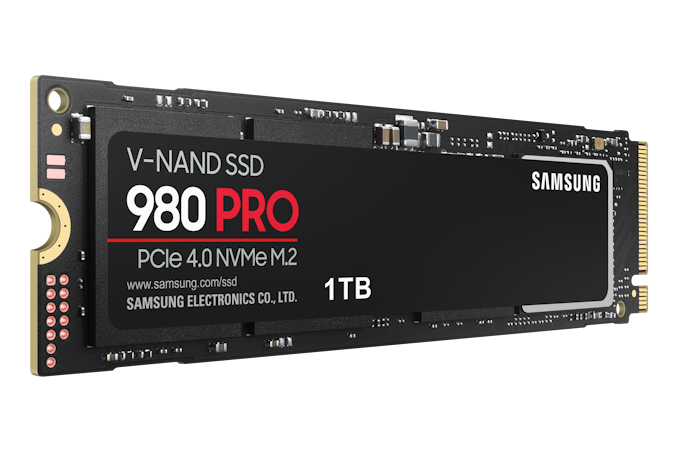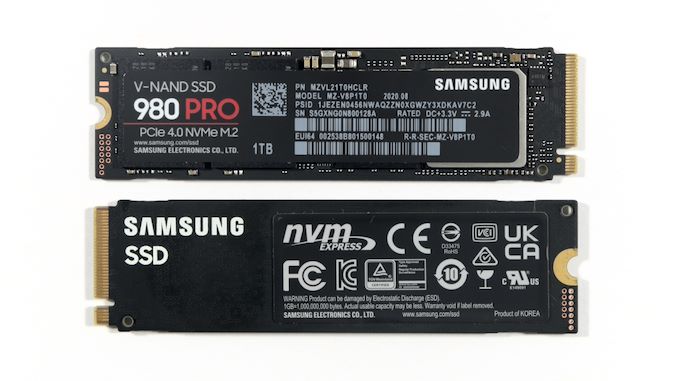The Samsung 980 PRO PCIe 4.0 SSD Review: A Spirit of Hope
by Billy Tallis on September 22, 2020 11:20 AM ESTSamsung 980 Pro: Top Shelf, No Drama
With the release this month of the Samsung 980 PRO, a new round of competition in the high-end SSD market is beginning. The 980 PRO boasts higher performance than any other consumer SSD currently available, including sequential reads at 7GB/s and random reads at up to a million IOs per second. Samsung is continuing their habit of retaking the SSD performance crown, and almost making it look easy. At the same time, the 980 PRO will be priced a bit more reasonably than previous Samsung PRO models thanks to the switch to more affordable TLC NAND. But focusing only on the raw performance capabilities of the 980 PRO can distract from its true purpose, and the real impact of the 980 PRO won't be as dramatic as those top line performance numbers would suggest.
The fundamental problem facing the 980 PRO and other high-end NVMe drives is that the rest of the system can't keep up. Very few real-world consumer workloads can keep this SSD busy enough to make good use of its full performance potential. Hitting 5-7GB/s or 1M IOPS certainly sounds impressive, but that's only possible in fairly unrealistic conditions. The high sequential transfer speeds can be of some use when transferring data between the 980 PRO and RAM or an equally fast SSD, but the peak random IO performance of the drive simply does not matter to consumers today.
PCIe 4.0 Testing Wasn't Easy: Watch This Space
Our soon-to-be-retired synthetic benchmark suite is single-threaded, and the new Ryzen-based testbed highlights the places where the old Skylake CPU has been the bottleneck for random IO. I don't consider this to be a serious problem with the results we've been reporting, because real-world applications need a lot more CPU time for processing data than they do for managing IO transfers. Hype for the upcoming generation of game consoles has suggested that future video games may reach the point of needing the equivalent of an entire CPU core to manage IO, but that's only after using the equivalent of several more cores to decompress data and feed it to a powerful GPU running the kind of game engine that doesn't exist yet. Our new benchmark suite will be designed with such workloads in mind, but current consumer workloads aren't there yet and won't be for at least a few years.

This is our PCIe 3.0 Intel Testing System.
We're building something similar for AMD Ryzen PCIe 4.0
Setting aside the issue of what the 980 PRO can do in contrived circumstances, it still offers improvements over Samsung's earlier TLC SSDs, but these are incremental changes rather than revolutionary. The 980 PRO is still constrained by the latency of NAND flash memory, even though Samsung's 128L TLC is a bit faster than their 92L and 64L generations. The switch to offering much larger SLC cache sizes probably matters a lot more than the addition of PCIe Gen4 support, and the modest power efficiency improvements are overdue.
With Enough Performance, Efficiency Should Be A Target
Moving to the latest NAND and using an 8nm process for the controller helps with power efficiency, but has nowhere near the impact of SK hynix's decision to build a high-end PCIe Gen3 SSD with a four-channel controller. For most consumer workloads that SK hynix Gold P31 is just as fast as the 980 PRO with its eight channel controller and twice the PCIe bandwidth.
Samsung's decision to use TLC NAND in the 980 PRO instead of the traditional MLC NAND for their PRO SSDs has raised some eyebrows, to say the least. Their PRO product line has long stood as one of the most premium options in the SSD market, and this change raises the question of whether the 980 PRO actually deserves that "PRO" moniker. This drive could easily have been labeled the 980 EVO instead, and it would have been a great successor to that product line.
By most measures and for most use cases, the 980 PRO is actually superior to the MLC-based 970 PRO. The addition of PCIe 4 support helps the 980 PRO deliver higher speeds than its predecessors, even though that's more forward-looking than an immediate benefit. The shortcomings relative to a hypothetical MLC-based PCIe 4 drive are also mostly hypothetical; workloads that truly require more write endurance than the TLC-based 980 PRO can provide should probably be handled by an enterprise SSD rather than any consumer/prosumer product. Even with TLC NAND, the 980 PRO offers buyers the security of knowing that the drive is more than capable of handling whatever they will throw at it, and that's reason enough for it to deserve the PRO label.
Samsung's Dilemma: What Goes Into A Mainstream 980 Evo?
But that does leave a gaping hole in Samsung's lineup where a more mainstream 980 EVO might go. Samsung probably wouldn't release a QLC-based NVMe drive using the EVO suffix while they are still trying to establish their QVO branding in the SATA SSD market. But using QLC NAND isn't the only way to make a more affordable mainstream alternative to the overkill that is the 980 EVO.
My bet is that Samsung is considering releasing another PCIe Gen3 drive, or a PCIe Gen4 drive that is significantly slower, cheaper and more power efficient. They've produced low-end client NVMe SSDs for the OEM market before, but never made a retail product out of them. Now might be the time for a successor to the PM971 and PM991 to find its way to the retail SSD market. Watch this space.












137 Comments
View All Comments
Billy Tallis - Thursday, September 24, 2020 - link
The reviewers guide indicated that Samsung plans to continue using the PRO/EVO/QVO branding, but they don't have any new EVO or QVO drives to announce at this time. That's part of why I expect the EVO to continue on as a more entry-level TLC tier, without switching to QLC.Luke212 - Wednesday, September 23, 2020 - link
Terrible release. No faster after all this time. And to be outclassed by E18 Phisonjtester - Wednesday, October 14, 2020 - link
how is it not faster when on most charts it's well above the last generation? Also, why is MLC going to matter when the 1tb MLC has the same endurance as a 2tb evo plus? So is there no point in anyone having a 970 pro, regardless of their use case?I can either have a 1tb 970 pro for $240 after various discounts and credits or I can have a 2tb 970 evo plus for $270 or a 1tb 980 pro for $190. So how to decide? I already have a 1tb 970 evo plus, but haven't built yet and want at least 2 or 3 samsung drives.
Tom Sunday - Wednesday, September 23, 2020 - link
I just recently purchased a pair of Samsung 2TB 970 EVO Plus NVMe's to basically upgrading my older PC. They are super fast at 3500 MB/s sequential read speed. Its particulary felt in the booting-up process for sure. I question the necessity of the 980 PRO PCIe 4.0 because how fast does one really needs to go. I would think that for a few seconds here and there it's not worth it to graduate up again to the 4.0 world.Oxford Guy - Thursday, September 24, 2020 - link
"I question the necessity of the 980 PRO PCIe 4.0 because how fast does one really needs to go."That's not the point here. The point here is that the "980 Pro" is an EVO masquerading as a Pro. As others have said, it's likely a maneuver to foist QLC junk as the "upgrade" to the EVO line.
Luckz - Thursday, September 24, 2020 - link
To validate your faster booting process claim, did you compare your "super fast 3500 MB/s sequential read speed" to a cheaper 2000 MB/s drive like an A2000, or merely to a HDD from ancient times? And if it's "a pair" and an "older PC", you're going to run out of PCIe lanes anyway, unless it's a reasonably beefy HEDT or you don't (really) need a graphics card.im.thatoneguy - Thursday, September 24, 2020 - link
Thank you for testing last 16GB stats. As someone who uses Nvme drives for offloading TBs of video footage at a time this is actually really helpful to my workflows.Any reason though why there are no Sabrent drives benchmarked? They seem to be the most popular and best selling on Amazon. Seems like a good test to see if they are a value or if they are just cheap.
Billy Tallis - Thursday, September 24, 2020 - link
Sabrent drives are mostly or all Phison reference designs, sometimes with a custom heatsink. So their Rocket and Rocket 4.0 are basically equivalent to the Seagate drives featured in this review.I do have the 8TB Sabrent Rocket Q, but paused testing of that to work on this review. The 8TB review will probably be my next one finished, but those big drives take a while to test.
clieuser - Sunday, September 27, 2020 - link
How fast the 980 pro with PCIE 3.0, not with PCIE 4.0?ballsystemlord - Tuesday, September 29, 2020 - link
Spelling error:"and thus having optimized products to go along with it has always been the case as new generations trump the told."
Excess "t":
"and thus having optimized products to go along with it has always been the case as new generations trump the old."
I'll read the rest when the benchmarks are completed.